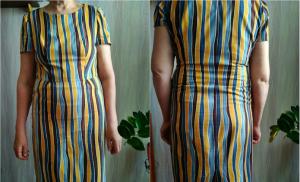Is it possible to embroider a dress if it is small. Dress a little
My mother, sorting through her wardrobe for the summer, suddenly realized that her favorite striped dress was not enough for her. Linen fabric was solid, retained the brightness of colors and it was simply a pity to send this thing to the trash. Therefore, we thought and decided to give this striped flight a second life. What can be done if the dress has become small and how to expand it - will be my today's master class. It is as simple as always, and even a beginner in sewing can repeat it.
- How to sew a skirt without a belt
The dress was too small. What to do?
If you look at the photo, you will see that this summer piece has a straight cut with a vent in the middle seam. Due to the fact that the dress has become narrow at the waist and hips, it pulls ugly on the back, forming folds. The slot diverges to the sides and if it is not removed, the fabric may tear in this place!

Mom and I thought and decided to sew a skirt out of a dress. It makes no sense to leave this thing in the form of a dress, you need to expand it on the sides to eliminate unnecessary fabric tension. And to make inserts to save as a dress - we do not have additional fabric. Therefore, I will sew a skirt with wedge inserts on the sides, without a belt. It will be an A - silhouette, or a bell skirt, just what you need if you do not have a pronounced waist or the waist is equal to the hips.
The dress was small in the hips. How to make inserts
1. I separate the top of the dress from the bottom, with scissors evenly passing along the waistline. It is not difficult to find it here - the dress is detachable at the waist. I use a ripper to remove all connecting seams, including overcast ones, and remove a hidden lock. As a result, I have two panels of the skirt - a shelf and a back (front and back).

2. I cut out two wedges from the remnants of the fabric. Isosceles triangles measuring 40 x 22 cm. I round them slightly at the bottom, raising the corners by 1 cm from the middle.

3. I attach wedges with tailor's pins alternately, first on the shelf, then on the back of the skirt. On a sewing machine, I perform a line observing an allowance of 1 cm. At the end, I do not reach the edge of 1 cm and perform a bartack.

4. In the end, this is what should happen. I process the cuts with a zigzag stitch. I iron all the seams of the wedges outward.

How to sew a zipper into a skirt without a belt
5. Now you need to put a secret lock. I will sew a zipper on the back, so I open the middle seam of the skirt to the length of the lock by 20 cm. Using a single-legged foot on a sewing machine, I sew a zipper. I try to get the needle as close to the clasp as possible, then the lock will definitely not be visible from the front side.

How to sew a skirt without a belt
6. To process the waistline on a skirt that does not have a belt, you need to tailor the facing. I cut out three strips from the fabric with a length equal to the upper cut, and a width of 6 cm. I make the edges slightly beveled.
- the first segment = the length of the front waist line (shelves) + 1 cm allowance on each side
- second and third = the length of the waist line of the back to the castle + allowance 1 cm on each side

7. I glue it with an adhesive cloth and connect them on a typewriter along the side sections. I iron the seams. I process the bottom edge of the facing with a zigzag or overlock stitch.

8. With tailor's pins, I attach the facing face to face to the upper cut of the skirt in a circle, while combining along the side seams. I lay out the hidden zipper as shown in the photo.

11. I sew the facing to the skirt, retreating from the edge by 1 cm. At the same time, the line does not reach the lock by 1 cm. This must be done so that the facing does not turn outward.

12. I turn the facing inside out and now I will process the zipper in a skirt without a belt. I will again need a single-horned foot for sewing on a hidden lock. After you complete the line on the typewriter along the edge of the castle, I cut off the corners, not reaching the line of 2 mm. In order to form a beautiful angle around the lock on the front side.

13. As a result, I get a hidden lock wrapped with a piping.

How to trim the bottom of a skirt
14. I'll show you how to beautifully work on the inside of the bottom cut of a skirt without a belt. I make the first line on a typewriter, bending the edge by 2 mm. inside. Then I fold the fabric inward again, fix the hem by 1.5 cm with pins, and from the inside I go through the first line on the typewriter.
Every woman in the closet has a good dozen dresses that she wore on some special occasion. But, once worn, they then gather dust on hangers for years, because you don’t want to put them on again, but it’s a pity to throw them away. Today we will tell our readers some great ideas on how to alter a dress and make yourself a new outfit from virtually nothing.
What's the secret?
A dress is the type of clothing that is easiest to transform into something else, more practical. It can be shortened and made from a maxi mini, lengthened with lace, sewn in, creating something more strict and sexy out of an outfit with a fluffy skirt, or you can simply add it with unexpected accessories and get a completely new and original look at the output.
Difficult alterations are best entrusted to an experienced dressmaker. With sufficient skill in such matters, transformations are made with their own hands. Altering a dress is not so easy, especially if it is made of inelastic and slippery fabrics (satin, chiffon, silk).
If you are not afraid of such difficulties, pay attention to the previous picture with four dresses. All of them are sewn according to a single pattern - they have the same bodice and outlines. The main differences are the length of the product and the decor of the top. This idea can also be used to alter the dress. How to do this is easy to guess, there are several options at once:
- you can adjust the length;
- change clothes by combining details cut from fabric of different colors;
- decorate part of the dress with lace, guipure or ruffle.
In order to make a two-tone outfit, you will have to rip the dress, separating the top from the bottom. A guipure T-shirt is sewn according to a specially made pattern, and then connected to the bottom. To prevent the part from slipping, it is better to fix it by stitching it to the belt and stitching it into the side seams.

Why can't you throw an old dress out of your grandmother's closet?
If a beautiful, but long unfashionable dress of your mother or grandmother is lying around in the closet, you can modify it by making yourself an actual outfit (and not even one). How to alter an old dress? The photo shows the dress before and after the alteration. It is enough to rethink the outfit a little to make it fashionable and modern:
- make a neater round neckline instead of the old angular one;
- reduce the armhole;
- slightly raise the waistline and decorate it with a narrow belt;
- choose a more favorable dress length.
If desired, a whole wardrobe can be made from the same grandmother's outfit without any problems. To do this, the dress is altered into a suit consisting of a skirt and blouse. Also, the image can be radically changed by adding a removable peplum to the top of the outfit. This blouse goes well with skinny trousers or a pencil skirt, and the skirt from this set looks perfect with a plain shirt in a classic cut.

Dress skirt
The most difficult job is to separate the bottom of the dress from the top and sew the skirt. How to redraw the product, we will tell in the master class. An old silk outfit is taken as the basis, from which a wonderful fluffy summer skirt is obtained:

- Lay out the dress and draw a rounded line across it (you first need to measure the approximate length of the future skirt). If you cut the fabric in a straight line, it will not fit nicely and the hem will be asymmetrical.
- Cut out the future skirt and evenly pick it up at the top.
- Cut out two strips of fabric for the belt (their length is the width of the gathered skirt plus 1-1.5 cm for the seams, and the width is 8-10 cm). Then the details must be swept and stitched to the product.
- In this skirt model, you need to sew a one-piece zipper, preferably a hidden one. It can be in the side seam or in the back. The zipper is inserted after the belt is sewn to the main part of the product. So that he does not puff, the skirt should be ironed well.
It is better to pre-duplicate the fabric on the belt detail with interlining, then it will become more rigid and will not wrinkle while wearing the skirt.

Making a dress from a long skirt
By the way, there may be another alteration (in the next photo). You can alter the dress from a skirt, only it should be an elongated style. It is best to choose a product made of airy cotton fabric with a colorful pattern. The whole course of work is described in the picture.

This dress is perfect for a beach walk, you can wear it over a top or swimsuit.
Wedding dress alteration
Wedding dresses are worn only once. This is right, but it's a shame - after all, things are so good and beautiful, the best day in the life of many girls is associated with them. This injustice can be corrected if the wedding dress is slightly altered. By the way, some salons already offer their clients outfits that transform without any problems even during the celebration. You can remove a train or several petticoats from them so that it is more convenient to move around, dance and just sit in a dress.

What else can be done with a wedding dress to wear it again? To start, trim the hem, making the length to the knee or mid-calf (a la 50s). It also does not hurt to remove excess decor from the bodice - usually wedding dresses are studded with rhinestones and pearls, but even the most elaborate evening attire cannot be so catchy. It is better to reduce the volume of a puffy Cinderella-style dress a little by removing a couple of layers of tulle, thanks to which it will not look like a tutu. Complex alterations, during which the style of the product completely changes, are best left to professionals. How to alter a long dress and change its silhouette, they know better than others.
There are many workshops on the topic of altering men's shirts. Aprons, sundresses, tops, skirts, blouses and even bombers are sewn from this simple wardrobe item. We offer to alter the shirt in a dress with buttons. To do this, you need to prepare a shirt of a very large size. The photo shows that a girl of average height does not have enough length to her knees by about one palm. But, if the shirt is a little shorter, it's not scary - it's just that the dress will turn out not so long.

This alteration is among the works of medium complexity. The shirt will need to change a lot:
- narrow and fit it;
- make tucks on the back and chest;
- flog long sleeves and replace them with small wings;
- finish the hem, cutting out wide strips from the remaining fabric.
It is better to wear such a dress under the belt to give it a more feminine shape.

Scarf plus dress
Another idea for transforming a dress with minimal effort, time and materials is to slightly alter its top. To do this, you will need to prepare a sufficiently long chiffon scarf that will blend well in color with the dress itself. It is not necessary that the accessory completely matches the color of the outfit, but it is still better if they visually harmonize with each other.
So, a scarf can be used in several ways:
- Make a belt out of it by tying a knot with a small bow on the back. The floors of the scarf will flutter beautifully at the back, which will make the image very gentle and romantic.
- Throwing it over the neck and fixing it under the belt, you can drape the shoulders and neckline.
- If you cover only one shoulder with a scarf, pulling the fabric at the top with a knot or chipping it with a brooch, the girl will look like a Greek goddess.

Simple Metamorphoses
For those who are afraid to ruthlessly cut their outfit or do not know how to alter a dress with minimal risk, you can try wearing your favorite piece of clothing differently than usual. It is enough just to change shoes, belt, bag and match a new cardigan to the dress, and it will look completely different. Even with the same simple dress, you can easily create at least five looks.
The details in this case are no less important than the main component. It is they who will help transform a modest dress into an evening outfit or make a set that is ideal for a romantic date. Shoes will play a big role here - the simpler the shoes, the more everyday the final image will turn out. Also, a new hairstyle, makeup and a positive attitude will help to diversify the style.
Despite the fact that it is still cold outside, it is time to prepare for warm days. Surely you have things of a quite presentable appearance lying around in your closet, but for various reasons they have not been worn for a long time. We offer to remake them into stylish and fashionable, thereby giving them a new bright life. Looking for something fresh and fun, we've rounded up some original ideas for you to update and remake t-shirts, blouses, shirts and sweaters. Share! Happy viewing!
Alteration of clothes from old to stylish with your own hands
Simply charming! Sew a lace strip into the top of the blouse. The idea is also suitable for a good quality knitted T-shirt.

An interesting model is to expand the back if the blouse has become cramped

Also a good idea: to expand the blouse with stripes of contrasting fabric in front and behind

Fashion trend - blouse with polka dots. If the blouse was made of one fabric, it would be boring, otherwise it’s even nothing, it turned out pretty

Refreshing the look of an old denim jacket or shirt never hurts. Especially if the denim jacket is several years old. Denim + plaid is a great combo. Always fresh and original!

We remake old jeans that have become small into a luxurious skirt. In the first option, we need only the upper part of the trousers, in the second - we rip the legs and sew in ruffles from bright fabric.

A sweatshirt with lace sleeves is wonderful, I have not seen such beauty in the store yet. Therefore, I will definitely take it and do it!

Sweatshirt sleeves can be connected to a shirt

Alteration of clothes from old to stylish with your own hands

Reworking jersey T-shirts is a favorite topic. Here is a simple and good idea to remake an ordinary T-shirt into a sexy piece. We cut off the elastic (neck), rip the seam on the sleeve and carefully hem everything. Sew on a satin stripe. Simple and tasteful!

We turn an ordinary t-shirt that fit into a chic spacious thing that will look great on a large figure. Just add silk or thin cotton to the tummy area and sleeves.

From two T-shirts we make something original. For alteration, a large (male) and small (female) were used. It turned out a nice country or home dress.

How to convert a T-shirt into a dress
And this dress from a T-shirt, not only for home - you can show it to the public

There are a lot of options to remake a knitted T-shirt or sweater in a dress. For example, an unnecessary checkered shirt + gray tunic. The main thing here is to choose the perfect color combination so that the skirt and top echo.

White sweater and old skirt, for example, for children

So, as a home wear it's ok
From a knitted T-shirt with light movements we make a fashionable top

We make interesting backs on knitted T-shirts

A lace insert on a T-shirt will ennoble and decorate a boring thing.

With such a simple method, you can expand a knitted sweater. From experience, it is better to insert knitted lace stripes or knitted fabric into a knitted T-shirt.

A knitted sweater, of course, can be arranged with an ordinary fabric, but then, keep in mind that an insert from such a fabric will not fit normally. What is visible in the photo below. For the house is a normal option, but not so much for the street.

We make a beach tunic from a T-shirt. As you can see, everything is very simple.

A beautiful idea is to decorate a T-shirt with bright fabric flowers. Just right for kids, especially if there is a non-erasable stain on T-shirts

An ordinary knitted T-shirt can be decorated with velvet ribbons or unusual braid

An old but relevant idea: A T-shirt + a scarf is an attractive thing. Moreover, all the details can be sewn by hand, without a sewing machine and troubles.

An idea for those who want to feel like a fashion designer - a thing suitable for the podium! T-shirt or blouse with chic sleeves.


If the neck of the T-shirt is stretched out, and you don’t want to throw it away at all, then you can do this: fold and sew

How to widen a tight neck on a T-shirt



T-shirt with fabric inserts on the sides - we get a completely feminine and not at all tight-fitting version of the stomach

Another stylish makeover for your favorite T-shirt

You can look irresistible in a dress only if the outfit is correctly sized and sits beautifully on the figure. Often women are faced with the problem that clothes shrink after washing or a couple of extra pounds are gained over the winter.
Definitely not an option to throw away the dress or give it to a friend. You can correct the situation by armed with scissors, threads and needles. So, what to do in cases where the product has become small, read in this article.
What to do if the dress is not enough
How to make a size larger? The first thing that comes to mind in this case is to lose weight urgently. But this option is not always successful and easy to implement, so it’s better to immediately turn to the second one - to embroider a tight dress.
In this case, further actions depend on the design of the product itself: the more seams and reliefs, the easier it is to alter a small dress and fit it to the desired size.
Before you get to work and alter a tight dress, you should take into account the advice of experienced tailors. In particular, these are:
- Before you start working with a new fabric, it must be washed and ironed. This will help avoid shrinkage of the product in the future and not spoil the finished outfit.
- If the product is new and a little small in size, you can simply carefully rip the seams and reduce the allowances. This option may seem inefficient, because it adds only a few millimeters of stuff on each side. However, in practice, it allows you to make the outfit much more spacious.
- If the dress needs to be slightly lengthened, then a small belt can be sewn in the waist area. A frill sewn from below, a gyupure, a contrasting insert or a fringe will also look neat, depending on the style and style of the outfit.
- If the outfit has become cramped in a certain place, then you first need to think about how to work in the problem area. For example, it is often necessary to embroider the area of the hips, shoulders or back.
Attention! Silk, linen, polyester, thin knitwear are difficult to re-stitch in the same areas: holes may appear on the seams or loops may come down. Therefore, be careful with products from the mentioned materials.
If you, considering options on how to make a thing a size larger, doubt your abilities, feel free to bring the product to the atelier. An experienced master will do the work at the highest level, taking into account all your wishes!
Tailoring your outfit

It is good if the product needs to be enlarged in one problem area. The most difficult situation arises when the dress needs to be expanded in the waist area - then it needs to be completely altered.
If the outfit is tight only in the hips or sleeves, then you should look for information on how to remake the thing on your own. It's not difficult at all and doesn't take much time. Depending on the location of the problem, you need to choose a plan of action:
On the sides. This is the easiest option - just carefully rip the thing along the side seams, remove excess threads and sew in some fabric prepared in advance, gyupur, wedges.
In the chest It is enough to add small inserts of fabric in front.
in the bust. If the thing is small in the specified area, then the best option would be to make a larger neckline or add ribbons, lace.
In back. There is one option here - to rip the thing and make inserts in the back area.
In length. Perhaps this is the simplest case - just add a wide ribbon at the bottom or pick up an insert from a similar fabric. To make the product more elegant, you can add a frill.
In width. If the product is straight cut, then you can make an insert in the front, back or sides. 
Making inserts
Remember! A dress is a type of clothing that covers almost the entire body and is always in sight. Therefore, you need to work with it carefully so that everything looks perfect.
To make inserts, you need to follow these steps:
- Prepare the dress: open the neckline, the bottom of the product. The thing must be steamed.
- Before cutting the clothes, you need to fold them, aligning the shoulder and side seams, hem and neck halves, reliefs and darts. With special pins, it is necessary to chop off all the combined seams, mark the semi-skid.
- If one strip will be used to increase the dress, then it is worth cutting the shelf along the half-skid line. If there are two strips, you need to attach a line to the half-skid, make a markup, retreat a certain number of centimeters from it and cut off both shelves.
- Next, it is worth proportionally reducing the neck. In order not to make a mistake, it is advisable to use your chest height measurement. The approximate formula looks like this: neck tuck solution - ready-made insert width subtract 1/3 from the finished insert. The top of the tuck should always be at least 2 centimeters above the chest line.
- Now you need to try on the product and cut off all unnecessary. If it is comfortable in such a thing, you can proceed directly to tailoring.
- It remains to make inserts, smooth the seams and the bottom of the neck.
Important! The fabric for inserts should be selected as similar in texture as possible to the main fabric of the product.
After such simple procedures, you can safely put on the finished outfit and feel irresistible in it! We also recommend watching a video on how you can make your favorite dress bigger if it has recovered or if it has decreased after washing:
22.09.2018 1 28 212 views
Many women are prone to spontaneous purchases. Therefore, after acquiring a new outfit, the question often arises of how to embroider a dress if it is small on the sides, narrow in the shoulders, too short, etc. Another option is also possible: the dress faithfully served its mistress while she was slender, like a birch, but as soon as she gained a couple of extra kilos, it began to look untidy.
Thoughts about altering clothes are visited by both avid needlewomen and girls who vaguely imagine which side to take on a needle and thread. A minimum sewing experience will still be required. In fact, there is nothing too complicated in this process, you just need to stock up on time, patience and our advice.
Going on a diet or altering?
The main dilemma that visits women in such a situation is what is easier - to remake yourself under a dress or a dress for yourself. Let's be honest: not everyone has the desire and willpower to lose weight. Sometimes health problems become an obstacle. But even in the case when a woman is ready to take care of her figure, she does not always have the necessary amount of time. For example, the outfit was purchased for the holiday, which will take place in a couple of days. In any case, it will not work to reduce your volumes by a size or even more in such a period.
Then there is only one way out: to increase the dress. You just first need to soberly assess this possibility: imagine how you would like to see the end result, understand whether this particular style is suitable for rework. If there are additional elements on the dress (frills, ruffles, coquettes), then after alteration they will successfully disguise the new inserts. And if it has a strict straight cut, then you will need to act very carefully so as not to spoil the impression of the outfit.
Before you get down to business, read the rules that will help you embroider the dress neatly and competently:
- If the dress has not yet been worn or has only been worn a couple of times, then the simplest solution is to open the side seams and reduce the allowance (of course, if its size allows this). So the outfit can be increased by a whole size, and no one will even notice anything.
- When choosing the size of the insert, keep in mind that a certain amount of material will go into the seam for the allowance. Do not make the outfit too tight - you should be comfortable to move. To expand a thing by 1 cm, you will need a 5 cm tissue flap, by 2 cm - by 6 cm, etc.
- Before sewing in, the material must be washed and ironed so that it takes its true size and does not sit down in the finished product, spoiling its appearance.
- If the sewn-in fabric contrasts with the dress itself, then you can add similar decorative elements to the sleeves and décolleté to make everything look harmonious.
- If only one particular place (chest or hips) does not fit in size, then it is permissible to make inserts only in this area. But when the waist is narrow, you have to alter the whole outfit.
How to embroider a dress if it is small in the hips, waist, chest?
If the clothes are tight only in the hips, then this simplifies the situation. It is not necessary to completely rip the seams along the entire length. You can limit yourself to the hip area and make wedge-shaped inserts on 2 sides. Just keep in mind that in this case, dark contrasting inserts are preferable. The light outer line of the hips will visually fill them.
If the outfit is cramped in the chest and shoulders, then there are possible solutions to the problem. The easiest way is to deepen the neckline. Of course, not every style allows this, so ribbons can be used as an alternative. They are inserted into a pre-opened seam and sewn. Sew one wide ribbon or twist several narrow ones together - the choice is yours.
The most difficult thing to fix the dress in the waist area. To do this, you will have to rip the seams from top to bottom: you can’t get by with short inserts - they will protrude sloppily. Therefore, a long piece of fabric is inserted along the entire length. It will be wider in the waist area, narrower in the chest and hips. But all transitions are made smooth, and then the material will not wrinkle.
Most importantly, do not overestimate your strength. If you feel that you cannot cope with the alteration yourself, contact professional seamstresses. It is also advisable if the product is expensive and there is a risk of spoiling it.
What if the dress is short?
Often the problem is not that you need to arrange the dress or increase its size, but the need to make the outfit longer. Methods for restoring a dress along the length will depend on the style and the desired image:
- Sewing on a strip of fabric that is similar in color and texture can be difficult, as the new seam at the bottom of the hem usually looks silly. As an option: make the insert not at the bottom, but at the waist, opening the transverse seams beforehand. However, not every style allows this possibility, therefore, in most cases, it is recommended to hem elements from a different fabric to the hem.
- It is better to purchase a wide lace ribbon and extend the dress to her, so it will look elegant and stylish.
- You can sew frills to the hem. It is also permissible to add them, for example, to the sleeves. This method is well suited for holidays, celebrations.
- An interesting effect is created by a dress with a bright strip of fabric, different in shade and pattern from the main material. Such a thing will look original and unusual.
- Sometimes you can not bother with fabrics at all, but sew fringe, tassels, woven beaded elements on the bottom. It will turn out a cheerful, playful outfit, especially appropriate in the summer.
How to choose a material for altering?
If the new dress did not fit in size or the old one became small, then before altering it, it is important to choose the appropriate material. There are different options here. The optimal, but at the same time boring solution is the selection of an identical fabric that is fully consistent with the original. This option is relevant for business images, when excessive frivolity and extravagance are not encouraged.
If the dress is festive or casual, it can be made more interesting by inserting a piece of fabric that differs in color and texture from the whole dress as a whole. Evening dresses can be sewn on the sides with mesh or guipure, giving the image of femininity and mystery. If you are not ready to wear transparent fabrics, then it is better to use a combination of silk or satin with a mesh top.
You can sew in inserts that contrast in color. Especially many successful combinations can really come up with for a black or white dress. When you buy material, be sure to take the outfit you are looking for with you to the store in order to immediately figure out if you like this or that combination. It is very important to choose high-quality fabrics that are easy to finish and do not require special manipulations and technical means when processing the edge.
Video: how to increase the size of a dress with your own hands?
How to alter a dress?
To alter a dress at home, you must follow the following algorithm of actions:
- We tear off the facing of the neck and hem. We act carefully so as not to damage the fabric. Carefully remove all remaining threads.
- We steam the dress to smooth out the creases.
- We align the product so that all the seams and darts match. We attach safety pins to the seams, piercing through two layers of fabric so that they do not move relative to each other.
- We mark the semi-skid with chalk and pins.
- If you plan to insert only one strip of fabric, then we cut the shelf along the intended line of half-skid. If there are two inserts, then both shelves will need to be cut off, departing a small distance from the markup.
- Now we will deal with the collar and chest area. To approximately calculate the opening of the neck tuck, you need to subtract 1/3 of its width from the total width of the insert. We mark the wedge-shaped insert, given that it should end a couple of centimeters above the chest line.
- Having made the markup and connecting all the elements with pins, we try on the dress. If everything fits, then you can cut off the excess material. We do this only after trying on, so that there is an opportunity to fix everything.
- We sew all the inserts on our hands or with the help of a sewing machine, iron the seams, put the collar and the bottom in order.
As you can see, expanding a dress on your own is not that difficult for someone with some sewing experience. If you have never held a needle in your hands, then it is better not to tempt fate: find out how much such a service costs in the studio, and trust the professionals.













